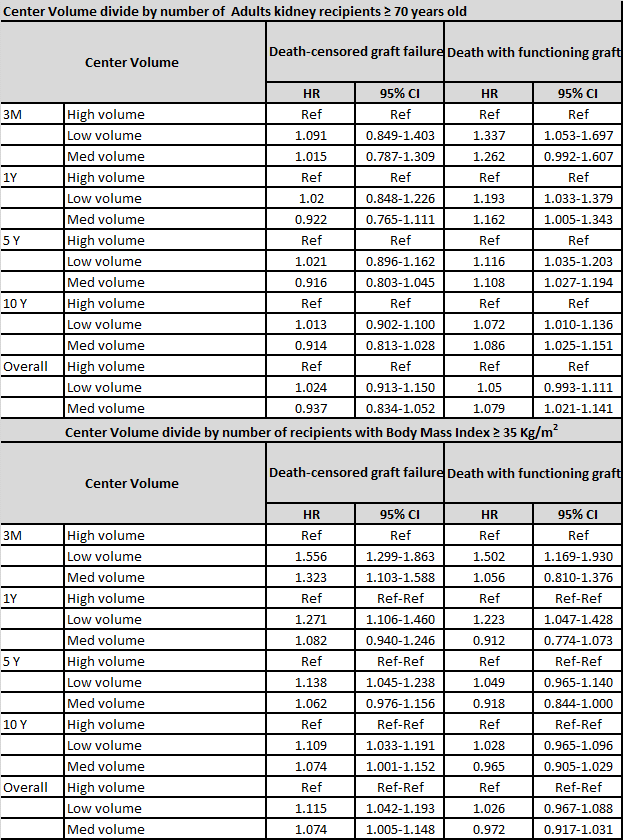Transplant Center Volume in High-risk Recipient Association with Graft and Patient Survival
Transplant, Washington University, Saint Louis, MO
Meeting: 2021 American Transplant Congress
Abstract number: 1055
Keywords: Graft failure, Graft function, Kidney transplantation, Renal dysfunction
Topic: Clinical Science » Kidney » Kidney Complications: Non-Immune Mediated Late Graft Failure
Session Information
Session Name: Kidney Complications: Non-Immune Mediated Late Graft Failure
Session Type: Poster Abstract
Session Date & Time: None. Available on demand.
Location: Virtual
*Purpose: Evaluation of high-risk recipients in transplant centers involves an intensive multidisciplinary medical evaluation and requires extensive coordination amongst various teams to follow-up on these patients. Understandably, this requires well thought out protocols and structures for patient safety. In this study, we explored the association of center volume with patient and graft survival in high-risk recipients.
*Methods: We reviewed OPTN data on kidney transplants on high risk recipients among 285 transplant centers between 2000 and 2016. High-risk recipients were defined as age ≥70 years old or BMI≥35 kg/m2. For each of these, transplant centers were categorized into tertiles of low, medium and high volume according to average annual transplant center volume for such transplant in high-risk recipients. The association of center volume with death censored graft loss (DCGL) and death with functioning graft (DWFG) were estimated using multivariable Cox regression including adjustment for recipient, donor, and transplant characteristics.
*Results: In recipients age≥ 70 years old, that there was an increased risk for DWFG in centers with low volumes of these patients at 3 month (aHR=1.337;1.053-1.697), 1 year (aHR= 1.193;1.033-1.379), 5 year (aHR=1.116;1.035-1.203), 10 year (aHR=1.072;1.010-1.136) but not overall (aHR=1.050;0.993-1.111). In centers with medium volumes of ≥ 70 years old recipients, there was an increased risk for DWFG at 1 year (aHR=1.162;1.005-1.343); 5year (aHR=1.116;1.027-1.194); 10 year (aHR=1.072;1.025-1.151) and overall (aHR=1.079;1.021-1.141). There was no difference in of DCGL in low and medium center volume for adults ≥ 70 years old. In centers with low volume for BMI≥ 35 Kg/m2 there was increase for DCGL at 3 month (aHR=1.556;1.299-1.863) , 1 year (aHR=1.271;1.106-1.1460), 5 years (aHR=1.138;1.045-1.238) and 10 years (aHR=1.109;1.033-1.191) and overall (aHR=1.115;1.042-1.193). In medium center volume for BMI≥ 35 Kg/m2 there was an increased risk for DCGL at 3 months (aHR=1.323; 1.103-1.508), 10 year (aHR=1.074;1.001-1.152) and overall (aHR=1.074;1.005-1.148).
*Conclusions: Kidney Transplantation of high risk recipients like those who are older and/ or with obesity requires a more thorough evaluation and structured follow up. In this study, we found there is room to improve in centers with lower and medium volume for older age recipients as well as those with BMI≥ 35 Kg/m2 to improve patient survival. Programs may need to establish more safety- net protocols targeted on such patients.
To cite this abstract in AMA style:
Merzkani MA, Murad H, Mattu M, Husami S, Wang M, Hu V, Chang S, Alhamad T. Transplant Center Volume in High-risk Recipient Association with Graft and Patient Survival [abstract]. Am J Transplant. 2021; 21 (suppl 3). https://atcmeetingabstracts.com/abstract/transplant-center-volume-in-high-risk-recipient-association-with-graft-and-patient-survival/. Accessed December 24, 2025.« Back to 2021 American Transplant Congress

